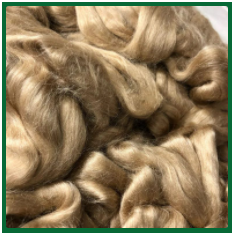India is home to varieties of raw silk, and tussar is one amongst the four varieties of silk – the others being Mulberry, Eri and muga silk.
The Mulberry silk is the most commonly cultivated silk from a silkworm named bombyx mori. The silk yarn fibre is characterised by a special brilliance, and the lustre reflects light in all directions.
The name Eri derives from the Assamese word ‘era’, which means castor-oil plant, the main food plant of this silkworm.

Muga silk is a native of Assam and the name Muga, in Assamesa, indicates the amber (brown) colour of cocoon. Belonging to the same family as tussar, what sets it apart is its natural golden colour and glossy texture. Muga Silk is obtained from semi-domesticated multivoltine silkworm called Antheraea assamensis.
The word Tussar derives from the Sanskrit word trasara,meaning the shuttle, and is mentioned in literature dating back to 1590 B.C.Tussar silk, called as the wild silk of India is obtained from a wild moth named antheraea millita which feeds on oak leaves. The two varieties of tussar predominantly found in India are classified into tropical tussar and temperate tussar.
The tropical tussar is abundantly found in the states of Jharkand, Chhatsigarah and West Bengal. The temperate variety is found mostly in the sub-Himalayan belt states of Assam, Manipur and Meghalaya.
Sericulture is the production of cultivated silks and an extremely labour intensive job. The processing of silks includes reeling, throwing and degumming of silks.
Reeling process combines the ends of filaments and winding to a circular frame to get uniformity of yarn. A slight twist imparted to the strands to hold them together is referred to as “throwing” of yarn. Degumming is the step in which the gum from the yarn is removed.

With the variety and texture of Tussar sarees available, these sarees are perfect to be used as a base sari to paint kalamkari or madhubani, block printed with sanganer or dabu prints, or just worn plain.
It is very important to understand the chemical composition of silk and take adequate care. Silk protein is called fibroin and made up of seventeen amino acids.
Since it an expensive fabric, silk needs special care. The best is to dry clean, but some silks can be hand washed with precautions. Always use detergents which are free from strong alkalis (like Genteel and Ezee), or hair shampoo. No usage of brush, which is too harsh for this delicate fibre.
Also, be careful while ironing silks. It is always better to use a damp muslin cloth above silks while steam ironing. And spraying of water directly on the silk fabric can lead to watermarks on the fabric.
Enjoy wearing your silks during this season!





